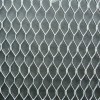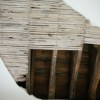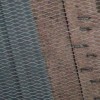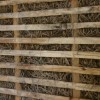Lath
Lath provides a means of holding plaster in place. Typically, three types of lath can be found throughout North America: wood lath, metal lath, and rock lath.
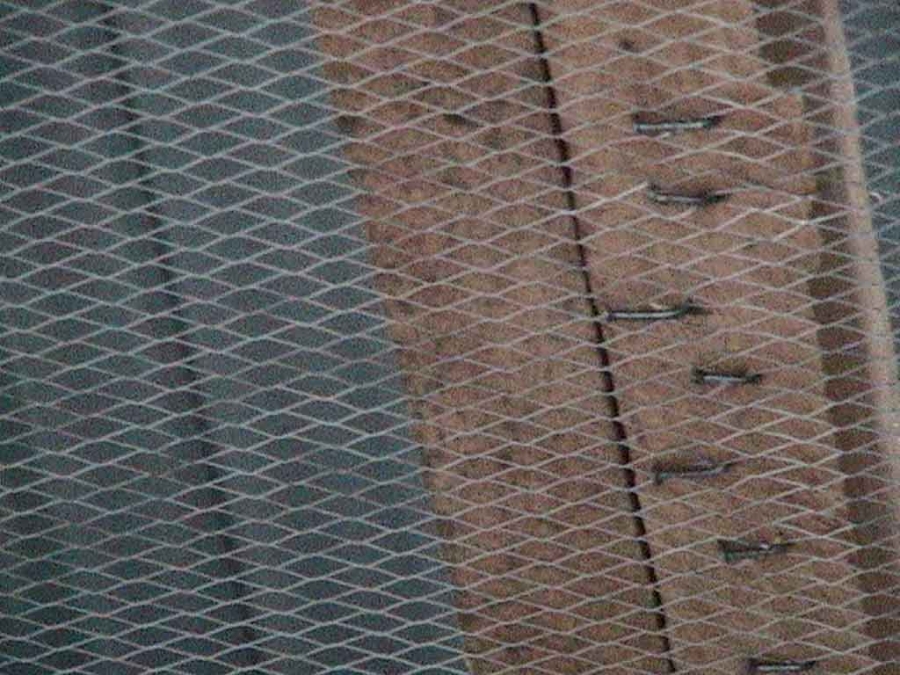
Wood lath came into common use 400 years ago, and was still seen regularly until about 70 years ago. Today, wooden lath is most commonly encountered in the New England area, and it is made of wood strips approximately 2 inches wide x 4 feet long. The strips used in historic structures had slightly undulating surfaces, as they were skillfully hand split from blocks of pine or hemlock. Because of these irregular surfaces, the hand split lath produced the best form of wooden lath. It afforded the plaster mixture many areas to “squeeze into”, so that it could harden and become “keys”. The keys are the mechanical locks which secure the plaster mortar to the wood. Introduction of the circular saw made possible the production of sawn lath strips in the 1800s. Cut from rough lumber, they are similar in size to split lath and have a "fuzzy" unfinished surface texture which bonds well with the plaster. The wall application remains the same and creates strong plaster keys. Wood lath is attached to the framing using either screws or nails, although nails are more common, especially in older homes. This type of wood lath remained popular until after World War II.
Metal lath, also called expanded metal lath, was patented in England in 1797. It has been on the market in North America since the early 1900s. It was created from sheets of thin steel that were rolled to form ribs. The ribs were slit at uniform spacing and the entire sheet was stretched to expand the slits. The stretching pulled the slits apart, creating a sheet of diamond shaped voids, which formed very effective keys. Metal lath and plaster became one of the first interior wall assemblies to be promoted as fireproof. At first used mostly in commercial applications, metal lath became more common residentially in the mid 1900s. Metal lath is attached to the framing using screws and can be bent to form complex shapes. Because of this, architects and designers are not limited to flat walls or boxed column wraps.
Rock lath, introduced in the first part of the twentieth century, also has become a commonly used lath system. Also called plaster board or gypsum-board lath, rock lath is made up of compressed Plaster of Paris or gypsum plaster and is covered with gypsum impregnated cardboard. Typically the board is 16" x 48" x 3/8", with some boards having perforations or textured surfaces to provide a key for the wet plaster. The gypsum in the paper also reacts with the wet plaster, forming a crystalline bond. The rock lath is nailed directly to the wall framing, which eliminates the need for a first coat or scratch coat of plaster that would normally be applied to the wood or metal lath. Using this technique is economical, as the room can be prepared and a second coat of plaster can be applied more quickly. In some variations, the scratch and the brown coats are eliminated and the finish coat is applied directly over the rock lath. By the late 1930s and through the 1950s, rock lath was almost exclusively used in residential construction.
The craftsmen of this timeless trade have had to hang their plaster materials onto something, whether ancient reeds, wood, metal or plaster boards. Time has shown that the above products have worked well in the past and will continue to work in the future.

Buildipedia Staff
The Buildipedia research and writing staff consists of dozens of experienced professionals from many sectors of the industry, including architects, designers, contractors, and engineers.
Website: buildipedia.com/
